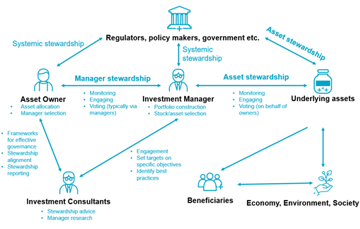Stewardship: time for real action, not just tick box reporting
Investment Responsible investment and stewardship Responsible investment
Stewardship has become central to responsible investment, but real stewardship goes beyond box-ticking exercises and annual reports. Stewardship is at risk of becoming a buzz word that conjures images of extra reports and paperwork rather than being seen for the opportunity it represents – to create long-term value for asset owners. Stewardship is used to address key concerns, for example around strategy and performance but is also key to addressing systemic risks such as climate change, social inequality and resource scarcity. These risks can have far-reaching consequences for investment portfolios and the wider financial system.
So, what should asset owners be doing to improve their approach to stewardship and what should they expect from their investment managers? In this blog, I will take a dive into this topic asking: stewardship – what does it actually mean?
At its centre, stewardship is the responsible allocation, management and oversight of capital to create long-term value. Stewardship aims to enhance and preserve the value of investments by managing risks and opportunities. Stewardship also helps asset owners address regulatory expectations, alignment of interests and systemic risks.
While much of the focus of stewardship has historically been on listed equities, stewardship is relevant across all asset classes. Effective stewardship requires active engagement and a long-term perspective across the entire investment portfolio, because systemic risks (such as climate change and social inequality) do not respect the boundaries of an asset class. A thorough stewardship strategy seeks to improve alignment of all investments with long-term sustainability goals, to support long-term financial goals.

To be successful, stewardship requires alignment between asset owners, consultants and asset managers. These are the roles that each should be playing:
- Asset owners: should define their stewardship expectations and priorities, and ensure that they are reflected in the design and execution of manager mandates. Asset owners should have oversight of their managers, monitoring stewardship activities carried out on their behalf, and engaging with managers to seek improvements in their stewardship if it falls short of expectations.
- Consultants: play a supporting role by providing manager research, monitoring activities, engaging with managers on behalf of asset owners and holding managers accountable.
- Asset managers: make the investment decisions and are responsible for voting at annual general meetings, engaging with management and other stakeholders, and addressing systemic risks through engaging with policymakers and regulators.
Managing risks and opportunities
Managing risks and opportunities is a core aspect of effective stewardship, ensuring that assets are resilient and positioned for sustainable growth. This involves monitoring potential challenges such as regulatory changes or market trends, while also capitalising on opportunities that align with long-term value creation. Doing so safeguards the value of investments but may also contribute to broader economic, societal and environmental stability.
Stewardship isn’t a compliance exercise
The regulatory landscape in the UK has increasingly put more focus on stewardship responsibilities for asset owners. For example, pension trustees are required to have voting and engagement policies and report annually on their implementation. Asset managers, asset owners and service providers that are signatories to the UK Stewardship Code 2020 must demonstrate how they create sustainable long-term value. Regulatory expectations formalise the need for stewardship but should not reduce it to a compliance exercise—it is an opportunity to drive meaningful change.
Getting your priories right
It’s important to get your priorities right. Prioritising short-term returns over longer-term risks (such as climate change) can often undermine portfolio resilience. Asset owners need to make sure that there is alignment between their investment philosophy, beliefs and interests and their asset managers’ practices. This is becoming ever more important in a world with growing political and regulatory divergence between Europe and America. If your manager is unable to achieve your stewardship goals it may be time to consider an alternative.
Investor Influence
Stewardship provides the tools – through engagement, collaboration, voting and asset allocation – to help investors mitigate systemic risks and promote resilience. Investors can address these risks by using their influence to engage with policy makers and regulators and drive coordinated responses. This won’t just tick a CSR box, but will actually help asset owners to build value within their portfolio that promoted economic progress and societal and environmental wellbeing.
What should asset owners expect from their managers?
Asset owners should ensure their managers deliver effective stewardship alongside financial returns. At LCP, we have published stewardship expectations for managers that reflect the importance of addressing systemic risks and achieving real-world outcomes. We expect managers to:
- Do the basics.
- Engage to improve.
- Seek to change the system.
- Tell the world.
Three things that asset owners need to ask themselves
To improve their approach to stewardship, asset owners need to think about the following things:
- Are your managers delivering on stewardship commitments, and how do they compare against their peers? Look at your consultant’s manager research views and compare against best-in-class alternatives.
- How effectively do you review and monitor your managers’ voting and engagement activities? Look at their significant votes and case studies to review and track progress of significant engagements over time (our dashboard can help with this).
- Do you have the governance capacity to oversee stewardship effectively, or would delegating to a consultant achieve a better result? Whether you chose to delegate or oversee stewardship directly, consultants can help to monitor and evaluate managers and scrutinise managers’ stewardship practices, engagement strategies and voting records. They can also work with asset owners to address concerns where managers fail to meet expectations.
Stewardship will help to address the systemic social and environmental issues that dominate our headlines daily. It’s a very real tool to combat these and help to ensure long term value for tomorrow’s finances, but if it’s to work effectively, it requires co-ordination between asset owners and asset managers and scrutiny of investment management practices.
Subscribe to our thinking
Get relevant insights, leading perspectives and event invitations delivered right to your inbox.
Get started to select your preferences.






